![]()
![]()
![]()
Use LEFT and RIGHT arrow keys to navigate between flashcards;
Use UP and DOWN arrow keys to flip the card;
H to show hint;
A reads text to speech;
32 Cards in this Set
- Front
- Back
|
What is trauma? |
Injury caused to living tissue caused by a force or mechanism extrinsic to the body It is one of the most common conditions effecting the skeleton |
|
|
How does trauma affect the skeleton? |
1. A partial to complete break of the bone (fracture or discontinuity) 2. An abnormal displacement or dislocation of the bone (dislocation) 3. A disruption in nerve or blood supply (necrosis) 4. An artificially induced abnormal shape or contour of thebone |
|
|
Why study trauma? |
- Victim Identification (medical records, xrays, implants, etc.) - Abuse, neglect, torture - Human rights investigation - Manner and cause of death? (e.g. famous personalities - suicide vs homicide) - Reconstructing events leading to death and any third party involvement |
|
|
3 types of trauma? |
1. Blunt force trauma (ex. punch - slow mph) 2. Sharp force trauma (ex. stab - slow mph) 3. Gunshot/projectile trauma (rapid m/sec) |
|
|
What are the 3 classifications for the occurrence of trauma? Why is it important to analyze this? |
1. Ante-mortem (before death) 2. Peri-mortem (around the time of death, most difficult to identify) 3. Post-mortem (after the time of death) Important for the determination of cause and manner of death |
|
|
What is the definition of Peri-mortem Trauma? |
around the time of death it is determine on the basis of evidence of the bio-mechanical fracture characteristics of fresh bone. Characteristics: • Sharp edges to the trauma site • No rounding from remodelling • Hinging – a section of bone is bent away from the direction of the blow • Formation of fracture lines which radiate from the point of impact • Staining from the haematoma is sometimes present |
|
|
What is the definition of Ante-mortem Trauma? |
Occurred before death and the person is healing or has healed. This should be visible on the skeleton. Characteristics of healing: • Smoothing and rounding of the edges of the break – sharp edges become blunt • Callus, extending some distance away from the fracture site *if injury has multiple stages of healing it can be the result of abuse |
|
|
Ante-mortem v. Peri-mortem |
AM can only be recognized if there is healing Callus formation can be problematic - look at if formation is in an early stage or later stage (difficult to determine sometimes) No evidence of healing = peri/post-mortem |
|
|
What is the definition of Post-mortem Trauma? |
No evidence of a vital reaction at all Caused by forces acting on the bone after death – e.g. taphonomy, animal action, excavation, handling etc Characteristics: • Breaks rarely exhibit radiating fracture lines • Bone is more likely to break like a dry twig. ‘Crumbling’ and break more easily than wet bone (will deform considerably prior to failure) • ‘Greenstick’ fractures and hinging (small pieces adhering to bone) are very rare • No radiating from an impact site on dry bone |
|
|
Peri-mortem v. Post-mortem |
The colour of the ends of the bone are usually distinct from the rest of the bone The fracture surface of newly postmortem fractured bone will differ in colour compared to the rest of the bone. • The lighter the colour, the more recent the break • If similar to rest of skeleton assumed to be contemporaneous • Breaks less clean and more jagged • Anatomical location of damage/injury • Analysis of clothing or skin for stabbing or gunshot |
|
|
Problems with identifying timing of trauma |
Dismemberment included as post-mortem – clearly taphonomic; BUT blunt, sharp, and gunshot trauma can be after death too Problem is that peri-mortem trauma is ambiguous since bone of a deceased will continue to respond (‘green’, ‘fresh’) to traumatic impacts in the same manner as living bone for a considerable amount of time after death E.g. butterfly fracture (wet bone properties as opposed to brittle) still occur months after death |
|
|
Heat induced Bone Traum |
Fracture patterns may indicate whether a skeleton was fleshed when burnt or whether only the dry bones were burnt. Burning fleshed remains results in curved, transverse fracture lines, irregular longitudinal splitting, twisting and marked warping Contextual setting is very important |
|
|
Burn pattern and Burn progress |
Pugilistic posture As limbs flex and muscles shrink, specific portions of body are shielded by the fire Colour gradient on a single bone can possibly be used as an indicator of thermal damage progression Less cracking and fractures from heat in dry bone than green or wet bone |
|
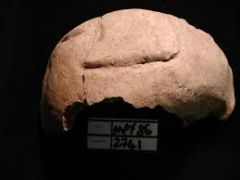
What is this type of trauma? |
Sharp Force Trauma An impact with an object with a cutting surface where the bone is incised (incised damage). Sharp edge or point object, precise forceful compression of skin which causes damage to underlying bone occasionally producing fractures. |
|

What is this type of trauma? |
Gunshot/Projectile Trauma Speed projectile or ‘ballistic trauma’ results from a fast moving object Trauma sustained from the discharge of a firearm. This can also include munitions Penetrating or perforating wounds that typically produce a brittle fracture response with little to no deformity |
|
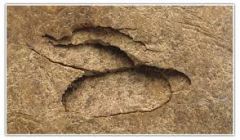
What is this type of trauma? |
Blunt Force Trauma When a bone fails (fractures) following an inability to resist extrinsic factors Classification of injuries involving low-velocity mechanical stress from broad and blunt surfaces. E.g. punches, kicks, blows with objects, falls, transportation accidents, crushing injuries non-penetrating wound with an instrument with a flat/round surface or large (surface) area wide area of impact on the bone |
|
|
Entrance and Exit Wounds |
Entrance •Oval/circular, Inwards bevel, High amount of fracturing Exit • Larger (energy dissipates outwards, including gasses), Bullet spin and deformity, Outwards beveling, Less fracturing |
|
|
Keyhole Ballistic Trauma |
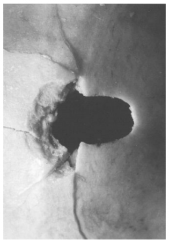
• Tangential strike • Shallow angle • Can be both entrance and exit • Entrance - Sharp edges • Exit - External bevelling |
|
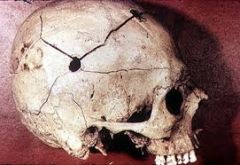
What type of trauma associated fracture is this? |
Radiating Fracture •Radiate from point of impact •Extend until energy absorbed •Even before bullet exits! •Will stop where energy is expended completely •Suture line |
|
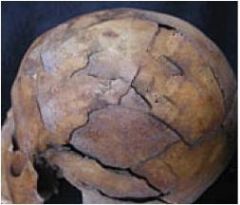
What type of trauma associated fracture is this? |
Concentric Fractures •High kinetic energy • Intracranial pressure not relieved with radiating fractures • Results in concentric heaving fractures - Arched patterns between preexisting radiating fractures |
|
|
Puppe rule of multiple injury ballistic fractures |
when two or more fracture lines of the skull produced by different blunt forces intersect, it is possible to reconstruct the sequence of injuries. The presence of bone damage from an initial injury causes subsequent injuries to stop in the point of intersection with the previous wounds. In the skull, the fracture lines produced by a second gunshot stops at pre-existing fractures of the skull. Subsequent radiating fracture will not cross a previous one• Force is expended out of the pre-existing fracture |
|
|
3 Types of Sharp Force Trauma Wounds |
• Punctures (umbrella, screwdriver) • Cleft (machete, axe, cleavers) • Incisions – knives, swords |
|
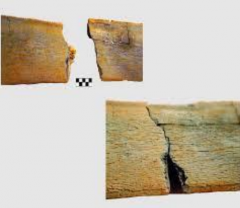
What type of SFT wound is this? |
Puncture Wound (stab-like) Vertical and cone-shaped Stabbing motion with point |
|

What type of SFT wound is this? |
Incision (cut) • Longer than wide • Slashing motion • Longer/sharper edge blade • Has an edge bevel on tool • Knives |
|
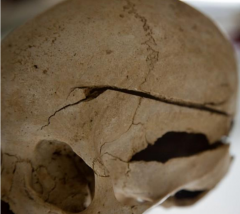
What type of SFT wound is this? |
Cleft • Vertical force - Can have associated radiating fractures from force • Long and sharp edge to the blade • Long and narrow mark on the bone • Axe • Machete |
|
|
Tool Mark Analysis |
• Relevant in differentiating saws • Complicated • Need to examine microscopically (width, depth, striations) • Think of a serrated steak knife - Multiple patterns |
|
|
Appearance of Blunt Force Trauma |

•Impact •Radiating fractures •Concentric fractures |
|
|
Sequencing the number of blows in BFT |
Points of impact have surrounding hoop or radiating fractures– this represents the minimum number of possible blows Radiating fractures that end at sutures or just run out of energy make the process of determining sequence of blows more difficult |
|
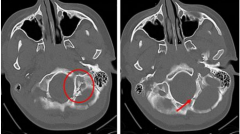
Basilar Skull Fracture |
Complete or partial fracture around foramen magnum •Compression of the vertebral column into skull •Fall from height |
|
|
Blunt Force Trauma to the Ribs |
Blunt force trauma to the ribs can cause fractures anywhere along their length, but especially at their anterior ends |
|
|
Blunt Force Trauma to the Vertebrae |
Vertebrae can sustain simple fractures of the transverse or spinous processes |
|
|
Blunt Force Trauma to the Scapula |
Blunt force trauma to the scapula can result in separation of the glenoid and coracoid from the body of the bone. |

